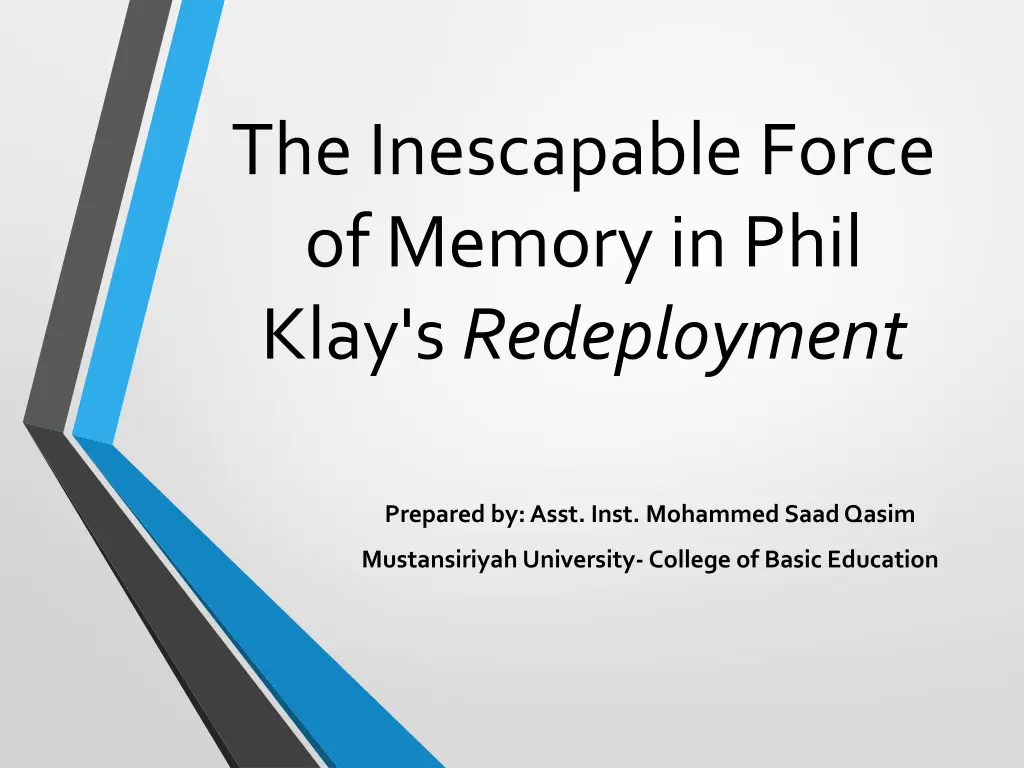
Understanding the Impact of Memory in Phil Klay's Redeployment
Explore the profound influence of memory on characters in Phil Klay's Redeployment, where haunting recollections from war shape lives and inhibit closure. Witness how memory serves as a force, trauma, and ghost that burdens and defines identities. Delve into the inseparable link between memory and experience in this captivating collection of stories.
Download Presentation

Please find below an Image/Link to download the presentation.
The content on the website is provided AS IS for your information and personal use only. It may not be sold, licensed, or shared on other websites without obtaining consent from the author. If you encounter any issues during the download, it is possible that the publisher has removed the file from their server.
You are allowed to download the files provided on this website for personal or commercial use, subject to the condition that they are used lawfully. All files are the property of their respective owners.
The content on the website is provided AS IS for your information and personal use only. It may not be sold, licensed, or shared on other websites without obtaining consent from the author.
E N D
Presentation Transcript
The Inescapable Force of Memory in Phil Klay's Redeployment Prepared by: Asst. Inst. Mohammed Saad Qasim Mustansiriyah University-College of Basic Education
Introduction to Redeployment Redeployment by Phil Klay is a collection of stories exploring the impact of war on soldiers. The stories capture the psychological effects of combat and the haunting memories that follow. Memory plays a central role, acting as a force that shapes and defines the characters' lives.
Memory as an Inescapable Force In Redeployment, memory is not a passive recollection but an active, haunting presence. Characters are unable to leave their experiences behind, making memory an unavoidable force.
Key Example: Redeployment even though I hated the past seven months and the only thing that kept me going was the Marines I served with and the thought of coming home,I startedfeelinglikeI wantedto go back. (Klay,2014,p.6) I sortof knew whereI was, butI didn tfeelhome. (Klay,2014,p.3) In the story 'Redeployment,' Sgt. Price is haunted by his memories of Iraq. He struggles with the transition back to civilian life, showing how his memories keep him emotionally in combat. This demonstrates how memories linger and prevent closure.
Key Example: Redeployment In Wilmington, you don't have a squad, you don't have a battle buddy, youdon'teven have a weapon.Youstartleten times checking for it and it's not there. You're safe, so your alertness shouldbe atwhite, butit's not. (Klay,2014,p.7)
Memory as Trauma Memories in Redeployment are often traumatic and disrupt the characters lives. These memories isolate soldiers from those who haven t shared their experiences. Klay portrays memory as a burden that distances individuals from normalcy.
The Symbolism of Being Haunted In Redeployment, memory acts as a ghost that refuses to leave the characters alone. This haunting shows how the past influences their present, often against their will.
Memory as Identity and Burden In Redeployment, memory defines who the characters are, even as it burdens them. The characters identities are shaped by their past experiences, showing the dual nature of memory. Memory is both a source of identity and a reminder of pain.
Conclusion Redeployment shows how memory acts as an inescapable force in soldiers lives. Klay s stories reveal how traumatic memories shape identity and disrupt the present. Memory in Redeployment embodies the theme of being 'haunted by the past.'






















